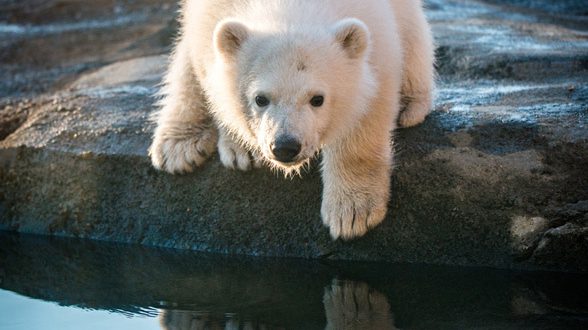
Not too long ago, Columbus College of Art & Design grad Grahm Jones (Photography, 1997) was a kid in Clintonville dreaming of photographing for National Geographic, spending his days among animals, and soaking up the outdoors. Now it might be the National Geographic photographers who would aspire to his job: photographer at the Columbus Zoo and Aquarium. So many things have changed since he landed his gig — he doesn’t use film, for one thing, and, well, Instagram. But Jones will tell you he still has the best job in the world.
CCAD alum Grahm Jones with a binturong. Photo by Amanda Carberry.
________
People call you the “zoo photographer,” but your job involves a lot more than photography.
My official title is Creative Services Specialist. The job covers the creation, editing, and archiving of all of the visual imagery (photographic and videographic) at the Columbus Zoo, Zoombezi Bay, Safari Golf Course, and the Wilds. This media is used internally for the zoo’s publications and promotions, grounds displays and signage, medical and training documentation for our Animal Health team and Animal Care staff (often shared with other institutions), the support of our philanthropic initiatives, and general documentation of all parks. My goal is to present our public with imagery that stirs their emotions and causes them to care about the Columbus Zoo’s mission.
What attracted you to commercial photography?
I came into CCAD interested in trying both animation and photography. In my foundation years, I just found that I was more drawn to photography. I was naturally drawn to the commercial side as a practical matter, with the idea that I would probably be more drawn to working for publications. My dream was National Geographic. Toward my final years at CCAD, I became increasingly interested in pursuing fine-art work, and I think that blending of sensibilities translates in my work.
What would you say to a CCAD student who might hesitate becoming a professional photographer in a social media-obsessed world?
Advances in technology and the popularity of social media have made everyone an image maker. Overall, I think this is a great thing. It allows for the collective sharing of so many perspectives and experiences that, a decade ago, the average person wouldn’t be exposed to. On the professional level, though, it can be very threatening, especially for photographers. While the recent “good enough” and “anybody can do it” mentality in mass media is certainly concerning, for the competent image maker, it should be seen as a challenge to push yourself to make something that truly stands out.
You can learn how to work all the bells and whistles. But when you’re pointing a camera at a human, you have to know how to make that person comfortable. I would expand that to an animal as well. That is one of the most important aspects of my craft here. It’s not very often you just walk up and take a picture of an animal. I often spend a lot of time around a particular animal, letting them get comfortable with me, before I get that shot.
What makes the zoo a good workplace for you?
This place has a tremendous staff. Everybody believes in what they do. When I’m working in close proximity to an animal, I always have someone from the care staff looking over my shoulder to ensure my safety as well as the animal's. There’s a tremendous amount of trust here, and there’s just a fantastic atmosphere here among people who really believe in what they’re doing.
Read The Columbus Dispatch’s May 2016 story about Jones.
